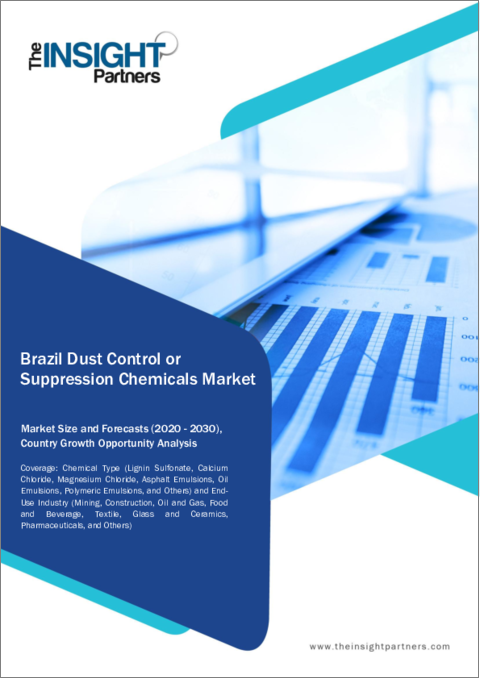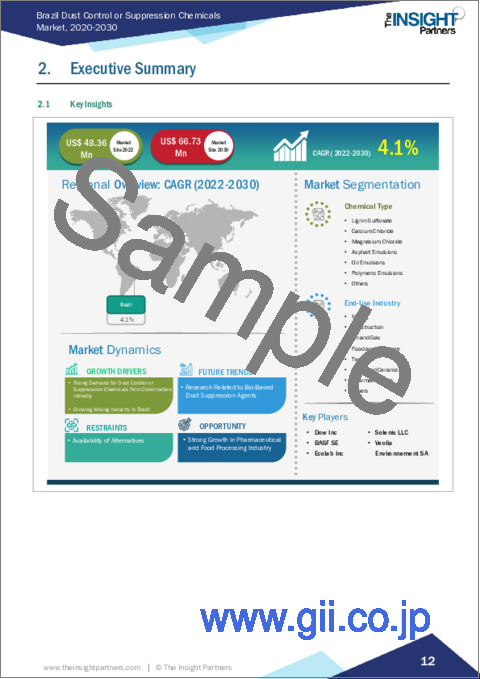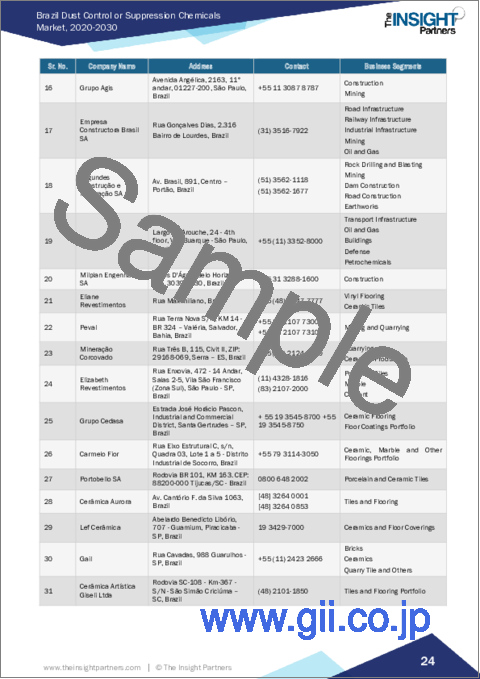|
|
市場調査レポート
商品コード
1389684
塵埃制御・抑制化学品のブラジル市場規模予測、化学品タイプ別・最終用途産業別の世界市場・地域シェア、動向、成長機会分析Brazil Dust Control or Suppression Chemicals Market Size and Forecasts, Global and Regional Share, Trends, and Growth Opportunity Analysis By Chemical Type and End-Use Industry |
||||||
|
|||||||
| 塵埃制御・抑制化学品のブラジル市場規模予測、化学品タイプ別・最終用途産業別の世界市場・地域シェア、動向、成長機会分析 |
|
出版日: 2023年11月13日
発行: The Insight Partners
ページ情報: 英文 86 Pages
納期: 即納可能
|
全表示
- 概要
- 図表
- 目次
ブラジルの塵埃制御・抑制化学品市場は、2022年に4,836万米ドルを占め、2030年には6,673万米ドルに達すると予測され、2022年から2030年までのCAGRは4.1%と推定されます。
塵埃制御・抑制化学品の利用は、建設現場、採鉱作業、道路整備、工業施設での用途が主な要因です。粉塵抑制化学薬品は、粉塵の排出を減らし、近隣地域の空気の質を改善するために建設現場で使用されます。採掘作業では、運搬道路や備蓄倉庫などから排出される粉塵を減らすために使用されます。これにより、作業員の健康を守り、健康リスクを減らすことができます。そのほかにも、工業施設からの粉塵排出の削減、解体現場からの粉塵の抑制、砂嵐の防止、都市部の大気環境の改善など、さまざまな用途で粉塵抑制剤が使用されています。さらに、ブラジルでは鉱業が盛んであり、建設活動も活発化していることから、ブラジルの防塵・抑制用化学品市場の成長が見込まれています。建設とインフラ整備は、粉塵抑制剤の需要増に大きく寄与しています。ブラジル政府は、コンセッション・オークションや規制改革のパイプラインを通じて大規模な民営化イニシアチブを取り、インフラ部門の開発資金を誘致しています。さらに、鉱業はブラジルの重要な歳入産業のひとつです。国際貿易局によると、2021年のブラジルの鉱業部門からの収益は、2020年に比べて62%増加しました。ブラジルは、鉄鉱石、マンガン、ボーキサイト、タンタライトの生産量がトップクラスです。同国の鉱業部門には、金、カオリン、ニッケル、石炭、リン鉱石の埋蔵量があります。これらすべての要因が、ブラジルの塵埃制御・抑制化学品市場の成長にプラスの影響を与えています。
最終用途産業に基づいて、ブラジルの防塵・抑制化学品市場は鉱業、建設、石油・ガス、食品・飲料、繊維、ガラス・セラミックス、医薬品、その他に区分されます。2022年のブラジルの塵埃制御・抑制化学品市場シェアは、鉱業セグメントが最大を占めました。粉塵抑制化学薬品は、粉塵の発生量を減らすために鉱業で使用されます。塵埃制御・抑制化学品は、運搬道路、ストックパイル、発破現場、コンベアベルトなど、採掘作業における様々な表面に使用されます。採掘中の空気中の粉塵の発生は、鉱山労働者の健康に悪影響を及ぼし、呼吸器系の問題、じん肺、その他のアレルギーを引き起こします。採掘作業における粉塵抑制は、空気の質の改善、環境への影響の低減、機器の寿命の延長、全体的な採掘の安全性など、いくつかの利点をもたらします。水噴霧システム、抑制化学薬品、霧吹きシステム、換気システムは、採鉱作業で広く使用されているいくつかの防塵・抑制システムのひとつです。さらに、建設業もブラジルの塵埃制御・抑制化学品市場の主要な最終用途産業です。防塵・抑制化学薬品は、未舗装道路、解体現場、掘削、備蓄など、建設現場のさまざまな表面に適用できます。粉塵抑制システムには、作業員の健康状態の改善、安全性の向上、環境への影響の低減など、いくつかの利点があります。ミストキャノンやウォータースプレーなどの自動粉塵抑制システムは、建設業界における粉塵抑制システムとして効果的です。さらに、石油・ガス産業では、未舗装道路、坑井現場、パイプライン、貯蔵施設など、さまざまな表面に粉塵抑制剤を散布しています。パイプラインの建設とメンテナンスは大量の粉塵を発生させるが、坑井現場での掘削と完成作業も粉塵の発生に大きく寄与します。石油・ガス業界のメーカーは、すべての従業員の安全な作業環境を維持するために、労働安全衛生局の基準を遵守しています。
Beneficent Technology Inc.、Veolia Environnement SA、Ecolab Inc.、Quaker Chemical Corp.、Dow Inc.、BASF SE、Solenis LLC、Borregaard ASAなどは、ブラジルの防塵・抑制化学品市場で事業を展開している企業の一例です。同市場で事業を展開する企業は、顧客の需要を満たすために高品質の製品を提供することに注力しています。また、市場での競争力を維持するために、新製品の発売、生産能力の拡大、提携、協力など、さまざまな戦略を採用することに注力しています。
ブラジルの塵埃制御・抑制化学品市場全体の規模は、一次情報と二次情報の両方を用いて算出されています。調査プロセスを開始するにあたり、市場に関する質的・量的情報を入手するため、社内外の情報源を用いて徹底的な二次調査を実施しました。また、データを検証し、トピックに関するより分析的な洞察を得るために、業界関係者に複数の一次インタビューを実施しました。本調査の参入企業には、副社長、市場開拓マネージャー、マーケットインテリジェンスマネージャー、国内営業マネージャーなどの業界専門家や、ブラジル防塵・制圧用化学品市場を専門とする評価専門家、調査アナリスト、キーオピニオンリーダーなどの外部コンサルタントが含まれます。
目次
第1章 イントロダクション
第2章 エグゼクティブサマリー
- 主要洞察
- 市場の魅力
第3章 調査手法
- 調査範囲
- 2次調査
- 1次調査
第4章 ブラジルの塵埃制御・抑制化学品市場情勢
- ポーターのファイブフォース分析
- 供給企業の交渉力
- 買い手の交渉力
- 新規参入業者の脅威
- 競争企業間の敵対関係
- 代替品の脅威
- エコシステム分析
- バリューチェーンのベンダー一覧
第5章 ブラジルの塵埃制御・抑制化学品市場:主要市場力学
- 市場促進要因
- 建設業界からの塵埃制御・抑制化学品需要の増加
- ブラジルにおける鉱業の成長
- 市場抑制要因
- 代替品の入手可能性
- 市場機会
- 製薬・食品加工産業の力強い成長
- 今後の動向
- バイオベースの粉塵抑制剤に関連する調査
- 影響分析
第6章 塵埃制御・抑制化学品市場:ブラジル市場分析
- ブラジルの塵埃制御・抑制化学品市場収益
- ブラジルの塵埃制御・抑制化学品市場数量(キロトン)
- ブラジルの塵埃制御・抑制化学品市場予測分析
第7章 ブラジルの塵埃制御・抑制化学品市場分析:化学品タイプ別
- リグニンスルホン酸塩
- 塩化カルシウム
- 塩化マグネシウム
- アスファルト乳剤
- オイルエマルジョン
- ポリマーエマルション
- その他
第8章 ブラジルの塵埃制御・抑制化学品市場分析:最終用途産業別
- 鉱業
- 建設
- 石油・ガス
- 飲食品
- テキスタイル
- ガラスとセラミックス
- 製薬
- その他
第9章 COVID-19パンデミックがブラジルの塵埃制御・抑制化学品市場に与える影響
- COVID-19前後の影響
第10章 業界情勢
- 製品発売
第11章 競合情勢
- 主要プレーヤーによるヒートマップ分析
- 企業のポジショニングと集中度
第12章 企業プロファイル
- Beneficent Technology Inc
- Veolia Environnement SA
- Ecolab Inc
- Quaker Chemical Corp
- Dow Inc
- BASF SE
- Solenis LLC
- Borregaard ASA
第13章 付録
List Of Tables
- Table 1. Brazil Dust Control or Suppression Chemicals Market Segmentation
- Table 2. Brazil Dust Control or Suppression Chemicals Market Revenue and Forecasts To 2030 (US$ Million)
- Table 3. Brazil Dust Control or Suppression Chemicals Market Volume and Forecasts To 2030 (Kilo Tons)
- Table 4. Brazil Dust Control or Suppression Chemicals Market Revenue and Forecasts To 2030 (US$ Million) - Chemical Type
- Table 5. Brazil Dust Control or Suppression Chemicals Market Volume and Forecasts To 2030 (Kilo Tons) - Chemical Type
- Table 6. Brazil Dust Control or Suppression Chemicals Market Revenue and Forecasts To 2030 (US$ Million) - End-Use Industry
List Of Figures
- Figure 1. Brazil Dust Control or Suppression Chemicals Market Segmentation, By Country
- Figure 2. Dust Control or Suppression Chemicals Market - Porter's Analysis
- Figure 3. Ecosystem Analysis: Brazil Dust Control or Suppression Chemicals Market
- Figure 4. Market Dynamics: Brazil Dust Control or Suppression Chemicals Market
- Figure 5. Brazil Dust Control or Suppression Chemicals Market Impact Analysis of Drivers and Restraints
- Figure 6. Brazil Dust Control or Suppression Chemicals Market Revenue (US$ Million), 2020 - 2030
- Figure 7. Brazil Dust Control or Suppression Chemicals Market Volume (Kilo Tons), 2020 - 2030
- Figure 8. Brazil Dust Control or Suppression Chemicals Market Share (%) - Chemical Type, 2022 and 2030
- Figure 9. Lignin Sulfonate Market Revenue and Forecasts To 2030 (US$ Million)
- Figure 10. Lignin Sulfonate Market Volume and Forecasts To 2030 (Kilo Tons)
- Figure 11. Calcium Chloride Market Revenue and Forecasts To 2030 (US$ Million)
- Figure 12. Calcium Chloride Market Volume and Forecasts To 2030 (Kilo Tons)
- Figure 13. Magnesium Chloride Market Revenue and Forecasts To 2030 (US$ Million)
- Figure 14. Magnesium Chloride Market Volume and Forecasts To 2030 (Kilo Tons)
- Figure 15. Asphalt Emulsions Market Revenue and Forecasts To 2030 (US$ Million)
- Figure 16. Asphalt Emulsions Market Volume and Forecasts To 2030 (Kilo Tons)
- Figure 17. Oil Emulsions Market Revenue and Forecasts To 2030 (US$ Million)
- Figure 18. Oil Emulsions Market Volume and Forecasts To 2030 (Kilo Tons)
- Figure 19. Polymeric Emulsions Market Revenue and Forecasts To 2030 (US$ Million)
- Figure 20. Polymeric Emulsions Market Volume and Forecasts To 2030 (Kilo Tons)
- Figure 21. Others Market Revenue and Forecasts To 2030 (US$ Million)
- Figure 22. Others Market Volume and Forecasts To 2030 (Kilo Tons)
- Figure 23. Brazil Dust Control or Suppression Chemicals Market Share (%) - End-Use Industry, 2022 and 2030
- Figure 24. Mining Market Revenue and Forecasts To 2030 (US$ Million)
- Figure 25. Construction Market Revenue and Forecasts To 2030 (US$ Million)
- Figure 26. Oil and Gas Market Revenue and Forecasts To 2030 (US$ Million)
- Figure 27. Food and Beverage Market Revenue and Forecasts To 2030 (US$ Million)
- Figure 28. Textile Market Revenue and Forecasts To 2030 (US$ Million)
- Figure 29. Glass and Ceramics Market Revenue and Forecasts To 2030 (US$ Million)
- Figure 30. Pharmaceuticals Market Revenue and Forecasts To 2030 (US$ Million)
- Figure 31. Others Market Revenue and Forecasts To 2030 (US$ Million)
- Figure 32. Heat Map Analysis by Key Players
- Figure 33. Company Positioning & Concentration
The Brazil dust control or suppression chemicals market accounted for US$ 48.36 million in 2022 and is expected to reach US$ 66.73 million by 2030; the market is estimated to record a CAGR of 4.1% from 2022 to 2030.
The utilization of dust control or suppression chemicals is majorly driven by their application in construction sites, mining operations, road maintenance, and industrial facilities. Dust suppression chemicals are used on construction sites to reduce dust emissions and help improve the air quality of nearby areas. In mining operations, it is used to reduce dust emissions from haul roads, stockpiles, and other sources. This helps to protect the health of workers and reduce health risks. In addition, dust suppression chemicals are also used in a variety of other applications, such as reducing dust emissions from industrial facilities, controlling dust from demolition sites, preventing dust storms, and improving air quality in urban areas. Further, the prevalence of the mining industry and growing construction activities in Brazil are expected to drive the Brazil dust control or suppression chemicals market growth. Construction and infrastructure development is a significant factor contributing to the rising demand for dust suppression chemicals. The Government of Brazil has taken a massive privatization initiative through the pipeline of concession auctions and regulatory reforms to attract financing for the development of its infrastructure sector. Further, the mining industry is one of the significant revenue-generating industries in Brazil. According to the International Trade Administration, Brazil generated 62% higher revenue from the mining sector in 2021 compared to 2020. Brazil is among the top iron ore, manganese, bauxite, and tantalite producers. The country's mining sector includes gold, kaolin, nickel, coal, and phosphates reserves. All these factors are positively influencing the Brazil dust control or suppression chemicals market growth.
Based on the end-use industry, the Brazil dust control or suppression chemicals market is segmented into mining, construction, oil & gas, food & beverage, textile, glass & ceramics, pharmaceuticals, and others. The mining segment accounted for the largest Brazil dust control or suppression chemicals market share in 2022. Dust suppression chemicals are used in mining to reduce the amount of dust formation. Dust control or suppression chemicals are used on a variety of surfaces in mining operations, such as haul roads, stockpiles, blasting sites, and conveyor belts. Airborne dust generation during mining negatively affects the health of miners, leading to respiratory problems, pneumoconiosis, and other allergies. Dust suppression in mining operations offers several benefits, such as improved air quality, reduced environmental impact, increased equipment lifespan, and overall mining safety. Water spray systems, suppression chemicals, misting systems, and ventilation systems are among the several dust control or suppression systems widely used in mining operations. Further, construction is another major end-use industry for the dust control or suppression chemicals market in Brazil. Dust control or suppression chemicals can be applied to a variety of surfaces in construction sites, including unpaved roads, demolition sites, excavation, and stockpiles. Dust suppression systems offer several benefits, such as improved worker health, increased safety, and reduced environmental impact. Automatic dust suppression systems such as misting cannons and water sprays are effective as dust control systems in the construction industry. Furthermore, Dust suppression chemicals are applied to a variety of surfaces, including unpaved roads, well sites, pipelines, and storage facilities in the oil & gas industry. Pipeline construction and maintenance generate a significant amount of dust, whereas drilling and completion operations in the well sites can also significantly contribute to dust formation. Manufacturers in the oil & gas industry adhere to Occupational Safety and Health Administration standards to maintain a safe working environment for all employees.
Beneficent Technology Inc., Veolia Environnement SA, Ecolab Inc., Quaker Chemical Corp, Dow Inc., BASF SE, Solenis LLC, and Borregaard ASA are a few of the players operating in the Brazil dust control or suppression chemicals market. Players operating in the market focus on providing high-quality products to fulfill customer demand. Also, they focus on adopting various strategies such as new product launches, capacity expansion, partnerships, and collaborations to stay competitive in the market.
The overall Brazil dust control or suppression chemicals market size has been derived using both primary and secondary sources. To begin the research process, exhaustive secondary research has been conducted using internal and external sources to obtain qualitative and quantitative information related to the market. Also, multiple primary interviews have been conducted with industry participants to validate the data and gain more analytical insights into the topic. The participants of this process include industry experts such as VPs, business development managers, market intelligence managers, and national sales managers-along with external consultants such as valuation experts, research analysts, and key opinion leaders-specializing in the Brazil dust control or suppression chemicals market.
Reasons to Buy:
- Highlights key business priorities in order to assist companies to realign their business strategies.
- The key findings and recommendations highlight crucial progressive industry trends in the Brazil dust control or suppression chemicals market, thereby allowing players to develop effective long-term strategies.
- Develop/modify business expansion plans by using substantial growth offering developed and emerging markets.
- Scrutinize in-depth the market trends and outlook coupled with the factors driving the market, as well as those hindering it.
- Enhance the decision-making process by understanding the strategies that underpin commercial interest with respect to products, segmentation, and industry verticals.
Table Of Contents
1. Introduction
- 1.1 The Insight Partners Research Report Guidance
- 1.2 Market Segmentation
2. Executive Summary
- 2.1 Key Insights
- 2.2 Market Attractiveness
3. Research Methodology
- 3.1 Coverage
- 3.2 Secondary Research
- 3.3 Primary Research
4. Brazil Dust Control or Suppression Chemicals Market Landscape
- 4.1 Overview
- 4.2 Porter's Five Forces Analysis
- 4.2.1 Bargaining Power of Suppliers
- 4.2.2 Bargaining Power of Buyers
- 4.2.3 Threat of New Entrants
- 4.2.4 Intensity of Competitive Rivalry
- 4.2.5 Threat of Substitutes
- 4.3 Ecosystem Analysis
- 4.4 List of Vendors in Value Chain
5. Brazil Dust Control or Suppression Chemicals Market - Key Market Dynamics
- 5.1 Market Drivers
- 5.1.1 Rising Demand for Dust Control or Suppression Chemicals from Construction Industry
- 5.1.2 Growing Mining Industry in Brazil
- 5.2 Market Restraints
- 5.2.1 Availability of Alternatives
- 5.3 Market Opportunities
- 5.3.1 Strong Growth in Pharmaceutical and Food Processing Industry
- 5.4 Future Trends
- 5.4.1 Research Related to Bio-Based Dust Suppression Agents
- 5.5 Impact Analysis
6. Dust Control or Suppression Chemicals Market - Brazil Market Analysis
- 6.1 Brazil Dust Control or Suppression Chemicals Market Revenue (US$ Million)
- 6.2 Brazil Dust Control or Suppression Chemicals Market Volume (Kilo Tons)
- 6.3 Brazil Dust Control or Suppression Chemicals Market Forecast and Analysis
7. Brazil Dust Control or Suppression Chemicals Market Analysis - Chemical Type
- 7.1 Lignin Sulfonate
- 7.1.1 Overview
- 7.1.2 Lignin Sulfonate Market Revenue and Forecast to 2030 (US$ Million)
- 7.1.3 Lignin Sulfonate Market Volume and Forecast to 2030 (Kilo Tons)
- 7.2 Calcium Chloride
- 7.2.1 Overview
- 7.2.2 Calcium Chloride Market Revenue and Forecast to 2030 (US$ Million)
- 7.2.3 Calcium Chloride Market Volume and Forecast to 2030 (Kilo Tons)
- 7.3 Magnesium Chloride
- 7.3.1 Overview
- 7.3.2 Magnesium Chloride Market Revenue and Forecast to 2030 (US$ Million)
- 7.3.3 Magnesium Chloride Market Volume and Forecast to 2030 (Kilo Tons)
- 7.4 Asphalt Emulsions
- 7.4.1 Overview
- 7.4.2 Asphalt Emulsions Market Revenue and Forecast to 2030 (US$ Million)
- 7.4.3 Asphalt Emulsions Market Volume and Forecast to 2030 (Kilo Tons)
- 7.5 Oil Emulsions
- 7.5.1 Overview
- 7.5.2 Oil Emulsions Market Revenue and Forecast to 2030 (US$ Million)
- 7.5.3 Oil Emulsions Market Volume and Forecast to 2030 (Kilo Tons)
- 7.6 Polymeric Emulsions
- 7.6.1 Overview
- 7.6.2 Polymeric Emulsions Market Revenue and Forecast to 2030 (US$ Million)
- 7.6.3 Polymeric Emulsions Market Volume and Forecast to 2030 (Kilo Tons)
- 7.7 Others
- 7.7.1 Overview
- 7.7.2 Others Market Revenue and Forecast to 2030 (US$ Million)
- 7.7.3 Others Market Volume and Forecast to 2030 (Kilo Tons)
8. Brazil Dust Control or Suppression Chemicals Market Analysis - End-Use Industry
- 8.1 Mining
- 8.1.1 Overview
- 8.1.2 Mining Market Revenue and Forecast to 2030 (US$ Million)
- 8.2 Construction
- 8.2.1 Overview
- 8.2.2 Construction Market Revenue and Forecast to 2030 (US$ Million)
- 8.3 Oil and Gas
- 8.3.1 Overview
- 8.3.2 Oil and Gas Market Revenue and Forecast to 2030 (US$ Million)
- 8.4 Food and Beverage
- 8.4.1 Overview
- 8.4.2 Food and Beverage Market Revenue and Forecast to 2030 (US$ Million)
- 8.5 Textile
- 8.5.1 Overview
- 8.5.2 Textile Market Revenue and Forecast to 2030 (US$ Million)
- 8.6 Glass and Ceramics
- 8.6.1 Overview
- 8.6.2 Glass and Ceramics Market Revenue and Forecast to 2030 (US$ Million)
- 8.7 Pharmaceuticals
- 8.7.1 Overview
- 8.7.2 Pharmaceuticals Market Revenue and Forecast to 2030 (US$ Million)
- 8.8 Others
- 8.8.1 Overview
- 8.8.2 Others Market Revenue and Forecast to 2030 (US$ Million)
9. Impact of COVID-19 Pandemic on Brazil Dust Control or Suppression Chemicals Market
- 9.1 Pre & Post Covid-19 Impact
10. Industry Landscape
- 10.1 Overview
- 10.2 Product launch
11. Competitive Landscape
- 11.1 Heat Map Analysis by Key Players
- 11.2 Company Positioning & Concentration
12. Company Profiles
- 12.1 1.1 Beneficent Technology Inc
- 12.1.1 Key Facts
- 12.1.2 Business Description
- 12.1.3 Products and Services
- 12.1.4 Financial Overview
- 12.1.5 SWOT Analysis
- 12.1.6 Key Developments
- 12.2 Veolia Environnement SA
- 12.2.1 Key Facts
- 12.2.2 Business Description
- 12.2.3 Products and Services
- 12.2.4 Financial Overview
- 12.2.5 SWOT Analysis
- 12.2.6 Key Developments
- 12.3 Ecolab Inc
- 12.3.1 Key Facts
- 12.3.2 Business Description
- 12.3.3 Products and Services
- 12.3.4 Financial Overview
- 12.3.5 SWOT Analysis
- 12.3.6 Key Developments
- 12.4 Quaker Chemical Corp
- 12.4.1 Key Facts
- 12.4.2 Business Description
- 12.4.3 Products and Services
- 12.4.4 Financial Overview
- 12.4.5 SWOT Analysis
- 12.4.6 Key Developments
- 12.5 Dow Inc
- 12.5.1 Key Facts
- 12.5.2 Business Description
- 12.5.3 Products and Services
- 12.5.4 Financial Overview
- 12.5.5 SWOT Analysis
- 12.5.6 Key Developments
- 12.6 BASF SE
- 12.6.1 Key Facts
- 12.6.2 Business Description
- 12.6.3 Products and Services
- 12.6.4 Financial Overview
- 12.6.5 SWOT Analysis
- 12.6.6 Key Developments
- 12.7 Solenis LLC
- 12.7.1 Key Facts
- 12.7.2 Business Description
- 12.7.3 Products and Services
- 12.7.4 Financial Overview
- 12.7.5 SWOT Analysis
- 12.7.6 Key Developments
- 12.8 Borregaard ASA
- 12.8.1 Key Facts
- 12.8.2 Business Description
- 12.8.3 Products and Services
- 12.8.4 Financial Overview
- 12.8.5 SWOT Analysis
- 12.8.6 Key Developments






